![]()
![]()
![]()
Use LEFT and RIGHT arrow keys to navigate between flashcards;
Use UP and DOWN arrow keys to flip the card;
H to show hint;
A reads text to speech;
16 Cards in this Set
- Front
- Back

DESIGN PRINCIPLES - BALANCE
|
principles of design-
balance- VISUAL WEIGHT - large objects are heavier than smaller of same form, shape, color & texture - highly detailed or textured objects are heavier than plain - dark elements are heavier than light - bright colors carry more weight than neutral - complex or unusual shapes weigh more than simple - several small objects closely grouped can balance single object with same area |
|
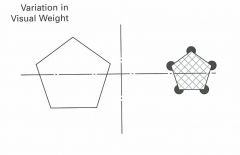
DESIGN PRINCIPLES - BALANCE
|
principles of design-
balance- VISUAL WEIGHT - large objects are heavier than smaller of same form, shape, color & texture - highly detailed or textured objects are heavier than plain - dark elements are heavier than light - bright colors carry more weight than neutral - complex or unusual shapes weigh more than simple - several small objects closely grouped can balance single object with same area |
|
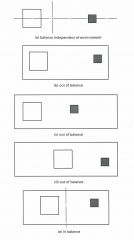
DESIGN PRINCIPLES - BALANCE
|
principles of design-
balance- AXIS POINT REQUIRED balance through positioning requires an axis or field: a. balance independent of environment b. out of balance c. out of balance d. out of balance e. in balance |
|
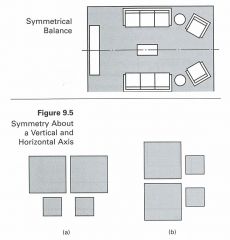
DESIGN PRINCIPLES - BALANCE
|
principles of design-
balance- SYMMETRICAL BALANCE 1- identical elements arranged equally about a common axis 2- a vertical axis works better than a horizontal axis a. group appears immediately balanced b. group appears immediately unbalanced |
|
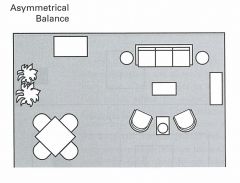
DESIGN PRINCIPLES - BALANCE
|
principles of design -
balance- ASYMMETRICAL BALANCE equalize visual (optical) weights of non-similar items in a composition within a visual field or about a common axis |
|
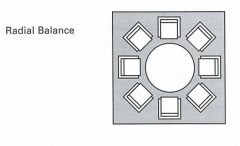
DESIGN PRINCIPLES - BALANCE
|
principles of design-
balance- RADIAL BALANCE elements arranged uniformly about a central point |
|
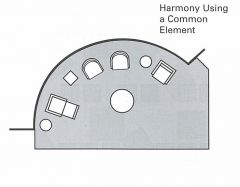
DESIGN PRINCIPLES - HARMONY AND UNITY
|
principles of design-
harmony and unity- COMMON ELEMENTS TO CREATE HARMONY dissimilar objects w/same basic scale can achieve harmony by: a. grouping b. relating to common architectural element c. organized around shared design feature HARMONY - the agreement of the part to each other and to the whole - all the pieces seem to belong together and work to reinforce the overall design theme - dissimilar elements w/ same basic scale achieve harmony by: a. grouping elements close together b. relating elements to a common architectural element c. elements organized around a shared design feature |
|
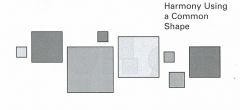
DESIGN PRINCIPLES - HARMONY AND UNITY
|
principles of design-
harmony and unity- COMMON SHAPE using a common shape in varying sizes and textures (similar to gestalt grouping) HARMONY - the agreement of the part to each other and to the whole - all the pieces seem to belong together and work to reinforce the overall design theme |
|
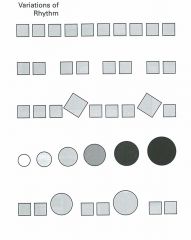
DESIGN PRINCIPLES - RHYTHM
|
principles of design-
rhythm- GRADATION size, color or value of elements are gradually modified as they repeat RHYTHM - repetition of elements in a regular pattern |
|

DESIGN PRINCIPLES - RHYTHM
|
principles of design-
rhythm- EMPHASIS rhythm can me most effective contrasted with unique element for emphasis RHYTHM - repetition of elements in a regular pattern |
|
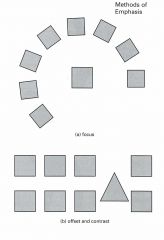
DESIGN PRINCIPLES - EMPHASIS & FOCUS
|
principles of design-
EMPHASIS & FOCUS a. focus- object can be centered, placed at axis termination or off-set from a rhythmic grouping b. size, color, shape or texture can create contrast emphasizing object from surroundings |
|
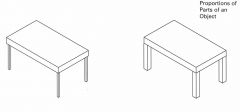
DESIGN PRINCIPLES - PROPORTION
|
principles of design-
proportion- RELATIVE TO OBJECT thin legs are dwarfed by thick top PROPORTION - is related to the surrounding objects (as opposed to scale which is dependent on human form) |
|
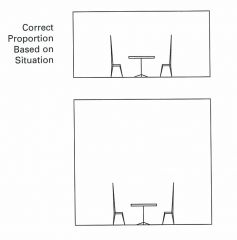
DESIGN PRINCIPLES - PROPORTION
|
principles of design-
proportion- RELATIVE TO SITUATION tall chairs seem crowded with low ceiling PROPORTION - is related to the surrounding objects (as opposed to scale which is dependent on human form) |
|
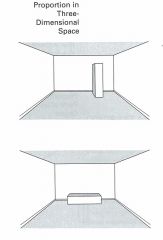
DESIGN PRINCIPLES - PROPORTION
|
principles of design-
proportion- RELATIVE TO 3D SPACE object seems top heavy unless laid on side PROPORTION - is related to the surrounding objects (as opposed to scale which is dependent on human form) |
|
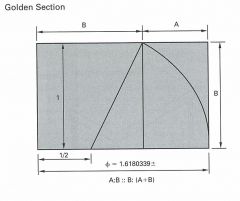
DESIGN PRINCIPLES - PROPORTION
|
principles of design-
proportion- THE GOLDEN SECTION the golden rule translated to a rectangle GOLDEN RULE- a single line is divided into two parts where one is half the size of the other as related to the whole line - A:B=B:(A+B) - phi - 1.618 - from the time of the greeks believed to be the most pleasing proportion - can be found in nature and in structures, artwork & musical harmony - related is the FIBONACCI SEQUENCE (each number = the sum of previous two numbers): 1, 1, 2, 3, 5, 8, 13..... |
|
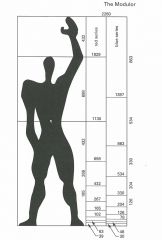
DESIGN PRINCIPLES - PROPORTION
|
principles of design-
proportion- MODULAR SYSTEM - created by Le Corbusier -loosely based on golden section - uses human body as starting point - main dimensions: 44, 72, 88 |

